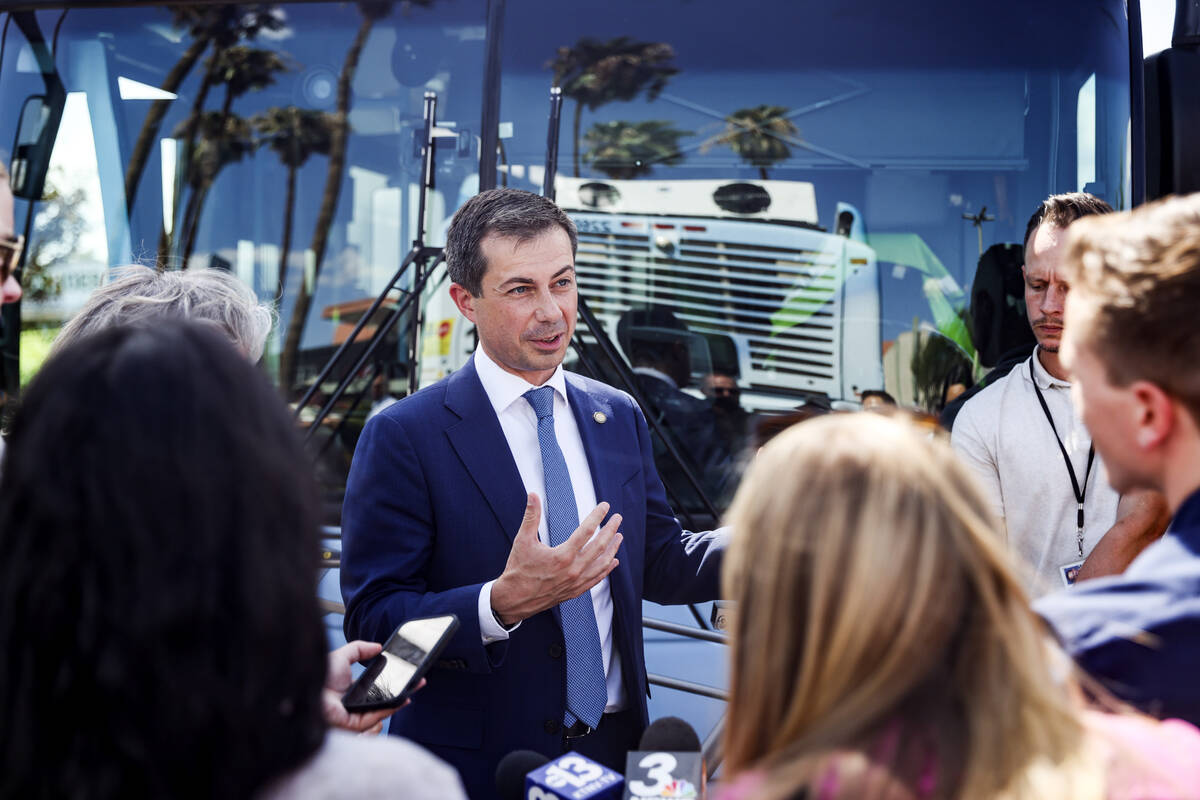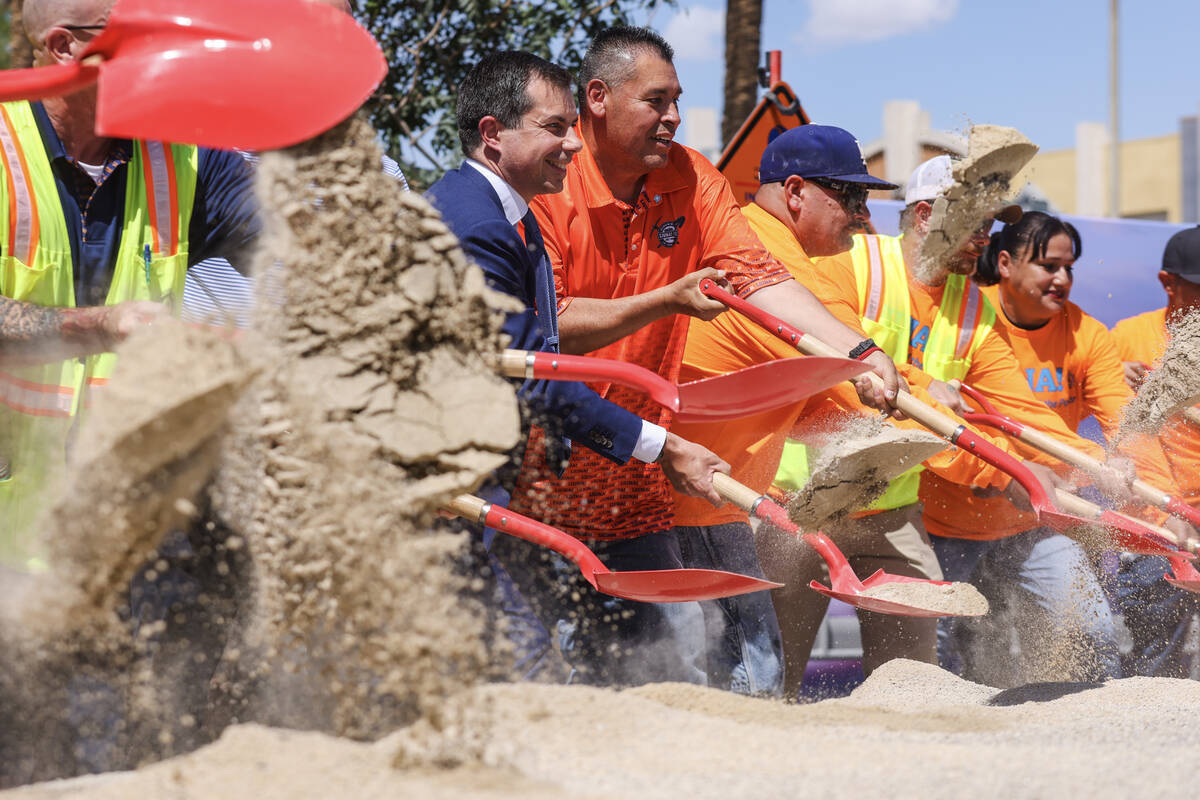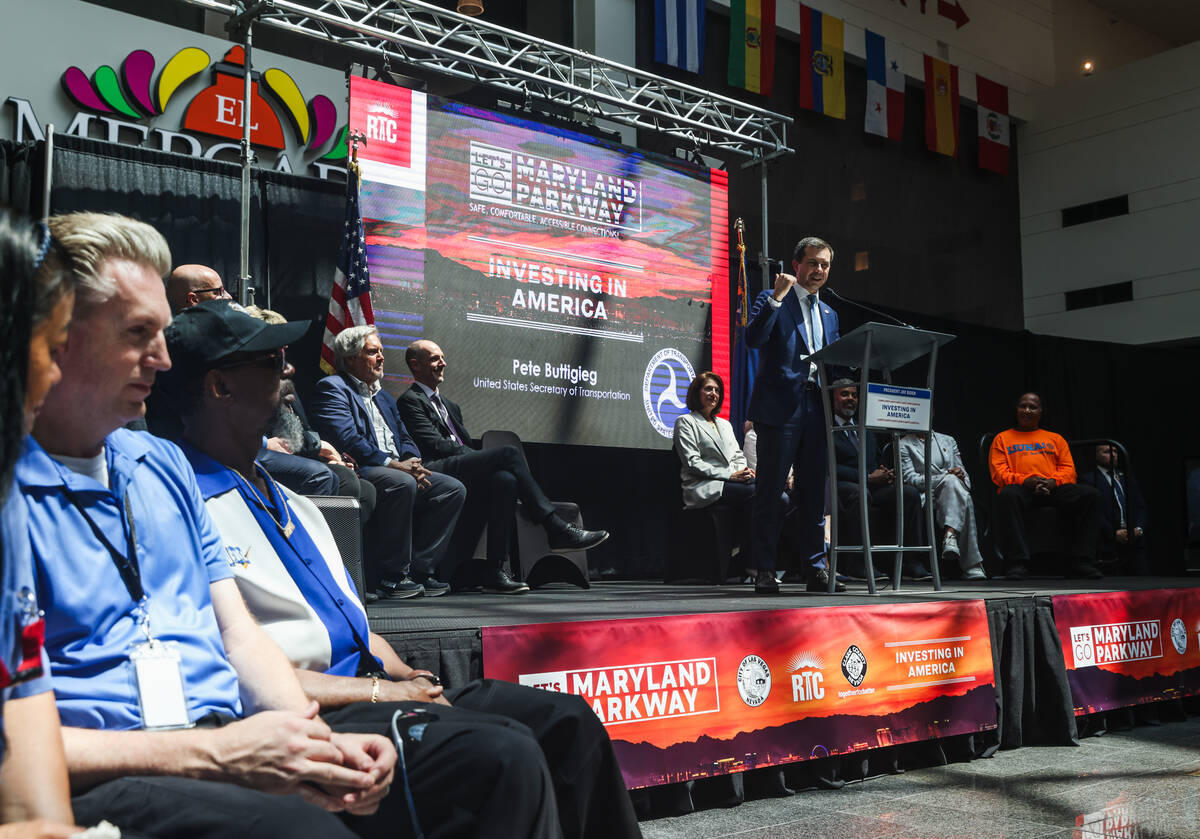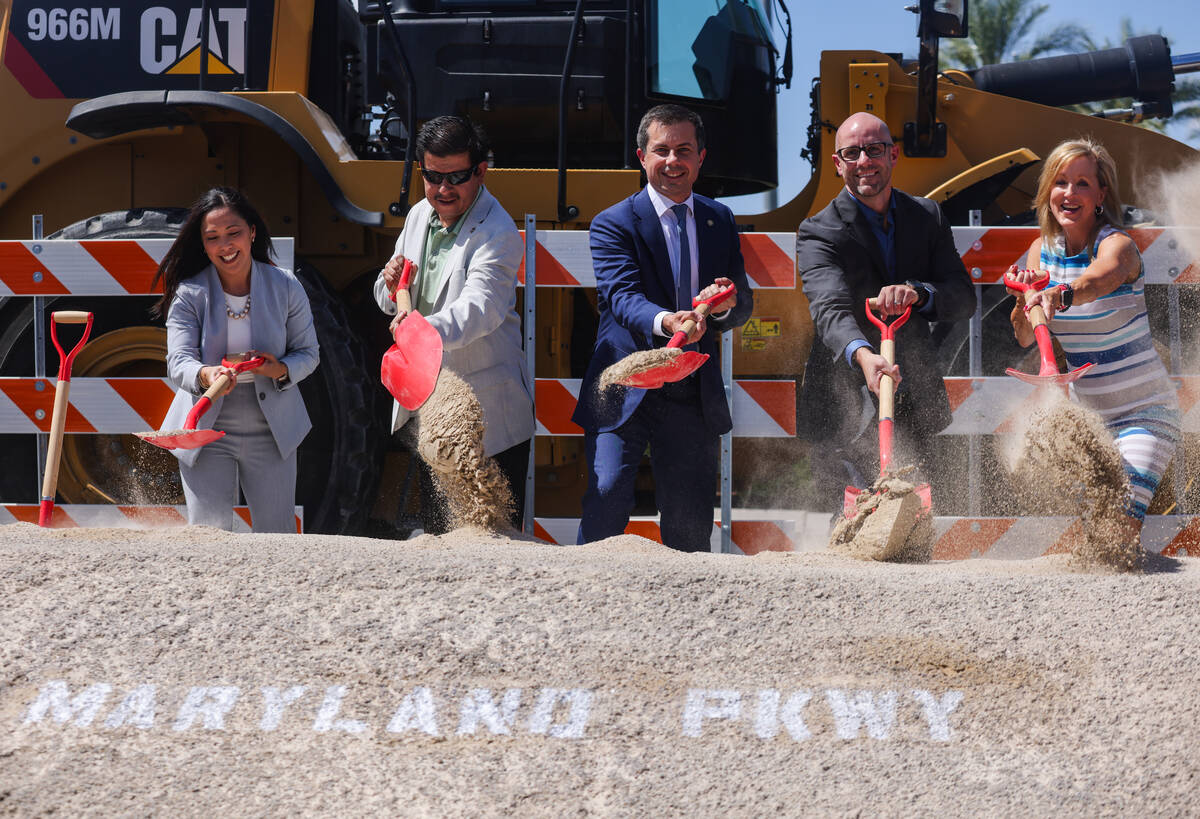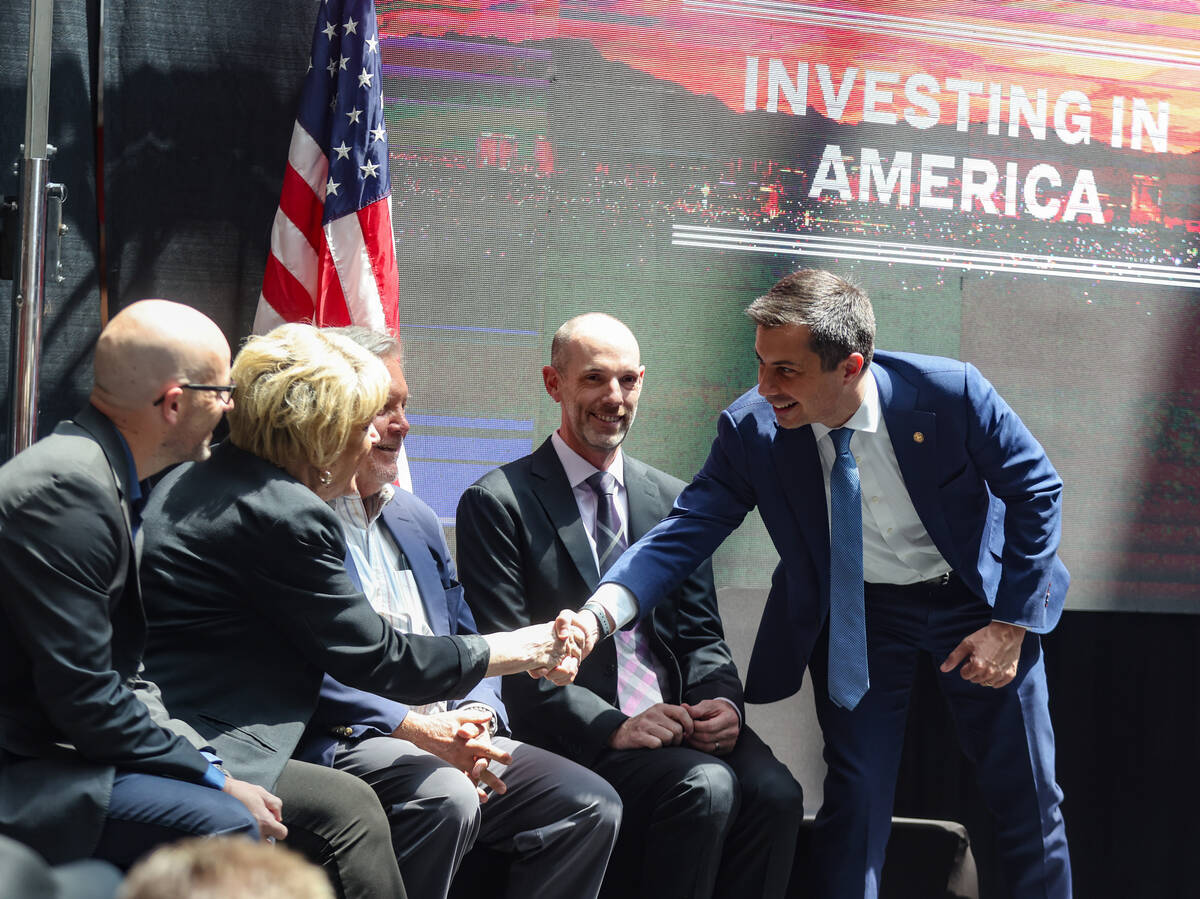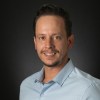More I-15 travel options needed in wake of fire fiasco, Buttigieg says
U.S. Transportation Secretary Pete Buttigieg said the Interstate 15 fiasco that wreaked havoc on motorists trying to travel to Las Vegas from Southern California last month spotlights the significance of adding alternative modes of travel, such as Brightline West’s planned intercity high-speed rail.
Interstate 15 northbound was shut down for almost two days last month after a truck carrying large lithium batteries overturned near Baker, California. The prolonged closure was because of the hazardous nature of the lithium battery fires, which produce chemicals and toxic gases.
During the closure motorists tried to detour around the crash via Interstate 40, leading to that highway becoming overly congested.
“This is one of the reasons why it’s important to create options and alternatives,” Buttigieg told the Las Vegas Review-Journal during an exclusive interview Monday.
“Look, any kind of disruption, the best thing is preventing it from happening in the first place. But it also helps reduce the congestion that is being put in these roads to begin with,” he said. “When you have different alternatives, like we’re introducing with these different investments that are taking place, as well as investing in I-15 itself, that’s going to mean a better future for people to get where they need to be.”
One alternative would be Brightline West’s high speed rail project and its planned $12 billion project to connect Las Vegas and Los Angeles via passenger rail. Brightline broke ground on the project in April, with plans to have the system completed and running in time for the 2028 L.A. Olympic Games.
Having crews better trained and providing access to needed equipment to clean up after such hazardous incidents, could help prevent similar long term closures of major arteries, like I-15, in the future.
“Anytime that you have hazardous material moving it’s important for first responders to have the training equipment needed to respond to that,” Buttigieg said. “We have had infrastructure problems, some created by moving gasoline and diesel and not sometimes by newer technologies, as well. As technology evolves, safety practices have to evolve too to stay ahead of that to make sure disruptions are minimized, and above all, to prevent injuries and fatalities.”
Vegas projects
Buttigieg was in Las Vegas for a pair of events, including the groundbreaking ceremony of the $378 million Maryland Parkway bus rapid transit line project. The project, which will revamp the 12.5-mile bus corridor between Harry Reid International Airport and the Las Vegas Medical District, received a $150 million federal grant earlier this year.
Plans include adding 7 miles of dedicated bus lanes running on Maryland Parkway, with bus shelters planned to be spaced a mile apart, with buses receiving traffic signal priority. The project is scheduled for completion sometime in 2026.
Localized projects such as the Maryland Parkway BRT are as important as any that are in the works across the nation, Buttigieg said.
“I think transit like this is critically important, especially because you’ve got a lot of workers who maybe don’t have a car, or it’s not reasonable or affordable to drive and park at their workplace every day,” Buttigieg said. “You have this bus rapid transit system, which importantly, will operate 24/7, knowing the shifts that many people work. Connecting downtown and the hospital and medical campus, the university and the airport, it’s going to open up a lot of jobs for so many people, at a time when access to those jobs and affordability is a real issue on everybody’s minds.”
The Las Vegas Valley has road improvement projects occurring in about every portion of town, with several new ones already on the pipeline.
Those local impact projects, such as the Maryland Parkway BRT, or the I-15-Tropicana project — which received a $50 million grant from the USDOT — are as a crucial as any in the entire country.
“What you have here is a lot of job growth and population growth and you’ve got to make sure that the infrastructure grows with it, otherwise, you’ll have a growth of congestion and pollution and frustration,” Buttigieg said. “That’s why we’re investing in so many ways in Southern Nevada. Whether it’s the Tropicana interchange with I-15, a major historic project like Brightline West to link people into Southern California without them having to get in a car… When your community is growing, your transportation systems have to grow with it. But up until now there hasn’t been the funding to do that. We are making up for lost time and then some.”
Potential for second airport
The continued growth of the Las Vegas Valley has also put some focus on the possible need for a second commercial airport to supplement Reid airport.
Local officials have been eyeing the potential for a second airport, to be located on land in Ivanpah, which is located just south of the valley, just west of I-15.
Buttigieg said if and when a second airport is built in Southern Nevada would largely be a local decision, but if it were to happen, there would likely be opportunities to secure federal funding to help make that possible.
“Whether we’re talking about capacity improvements at existing airports or expanding what’s possible, we’re going to be here as much as possible with funding in the Biden-Harris infrastructure plan,” Buttigieg said. “And it includes an extraordinary amount of funding for America’s airports, including one we’re looking forward to making tomorrow about the latest round of grants.”
Contact Mick Akers at makers@reviewjournal.com or 702-387-2920. Follow @mickakers on X.



